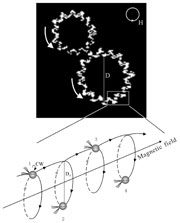|
Geomagnetic Field and Deep Earth Interior Processes
|
An article written by Prof. Pan Yongxin was selected as a research highlight by Nature China
An article entitled "Reduced efficiency of magnetotaxis in magnetotactic coccoid bacteria in higher than geomagnetic fields" written by Prof. Pan Yongxin,was selected as a research highlight by Nature China. The following is the report: Contrary to popular belief, the migration velocity of certain types of magnetotactic bacteria actually decreases as the magnetic field strength increases Original article citation Pan, Y. et al. Reduced efficiency of magnetotaxis in magnetotactic coccoid bacteria in higher than geomagnetic fields. Biophys. J. 97, 986–991 (2009). Magnetotactic bacteria possess an ability known as magnetotaxis, which allows them to use the Earth's magnetic field to navigate during migration. The classical model of magnetotaxis predicts that the migration velocity of magnetotactic bacteria increases monotonically with the strength of the magnetic field, but a team led by Yongxin Pan at the Chinese Academy of Sciences in Beijing, China, and Michael Winklhofer at Ludwig-Maximilians-Universität in Munich, Germany1, has found otherwise. The researchers tested the classical model experimentally using MYC-1, a type of magnetotactic bacteria extracted from the sediments of Lake Miyun near Beijing. Each MYC-1 bacterium possesses a magnetosome chain that serves as the compass needle for navigation, and two bundles of flagella that serve as propellers for locomotion. Normally, MYC-1 bacteria move along the magnetic field lines on a helical trajectory, but in a rotating magnetic field, they swim on a circular path (see image). The researchers studied the migration velocity of MYC-1 bacteria under an applied rotating magnetic field. They found that the migration velocity decreased as the magnetic field strength increased from 0.1 mT, equivalent to the Earth's magnetic field, up to 1.5 mT. One explanation for this unexpected observation is that the magnetosome chain of MYC-1 is inclined with respect to the flagellar propulsion axis. The effect, however, is apparent only in magnetic fields greater than 0.1 mT, suggesting that magnetotaxis is optimized for the Earth's magnetic field. |
Head of Group

Prof. Pan YongxinDivision of the Earth's Deep Structure and Process Tel:86 010 82998406 Email:yxpan@mail.iggcas.ac.cn |
-
SIMSSecondary Ion Mass Spectrometer Laboratory
-
MC-ICPMSMultiple-collector ICPMS Laboratory
-
EM & TEMElectron Microprobe and Transmission Electron Microscope Laboratory
-
SISolid Isotope Laboratory
-
StIStable Isotope Laboratory
-
RMPARock-Mineral Preparation and Analysis
-
AAH40Ar/39Ar & (U-Th)/He Laboratory
-
EMLElectron Microscopy Laboratory
-
USCLUranium Series Chronology Laboratory
-
SASeismic Array Laboratory
-
SEELaboratory of Space Environment Exploration Laboratory
-
PGPaleomagnetism and Geochronology Laboratory
-
BioMNSFrance-China Bio-mineralization and Nano-structure Laboratory


